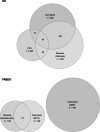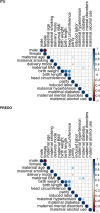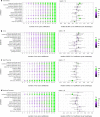Characteristics of epigenetic aging across gestational and perinatal tissues
- PMID: 33926514
- PMCID: PMC8082803
- DOI: 10.1186/s13148-021-01080-y
Characteristics of epigenetic aging across gestational and perinatal tissues
Abstract
Background: Epigenetic clocks have been used to indicate differences in biological states between individuals of same chronological age. However, so far, only few studies have examined epigenetic aging in newborns-especially regarding different gestational or perinatal tissues. In this study, we investigated which birth- and pregnancy-related variables are most important in predicting gestational epigenetic age acceleration or deceleration (i.e., the deviation between gestational epigenetic age estimated from the DNA methylome and chronological gestational age) in chorionic villus, placenta and cord blood tissues from two independent study cohorts (ITU, n = 639 and PREDO, n = 966). We further characterized the correspondence of epigenetic age deviations between these tissues.
Results: Among the most predictive factors of epigenetic age deviations in single tissues were child sex, birth length, maternal smoking during pregnancy, maternal mental disorders until childbirth, delivery mode and parity. However, the specific factors related to epigenetic age deviation and the direction of association differed across tissues. In individuals with samples available from more than one tissue, relative epigenetic age deviations were not correlated across tissues.
Conclusion: Gestational epigenetic age acceleration or deceleration was not related to more favorable or unfavorable factors in one direction in the investigated tissues, and the relative epigenetic age differed between tissues of the same person. This indicates that epigenetic age deviations associate with distinct, tissue specific, factors during the gestational and perinatal period. Our findings suggest that the epigenetic age of the newborn should be seen as a characteristic of a specific tissue, and less as a general characteristic of the child itself.
Keywords: Chorionic villi; Cord blood; Early development; Epigenetic age; Epigenetic clocks; Perinatal tissues; Placenta.
Conflict of interest statement
EB is the coinventor of FKBP5: a novel target for antidepressant therapy, European Patent no. EP 1687443 B1, and receives a research grant from Böhringer Ingelheim for a collaboration on functional investigations of FKBP5. Otherwise, the authors declare that they have no competing interests.
Figures




References
Publication types
MeSH terms
Grants and funding
LinkOut - more resources
Full Text Sources
Other Literature Sources
Medical

